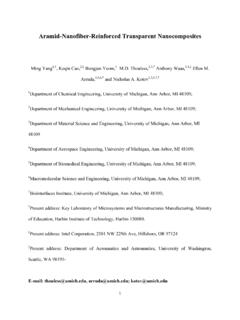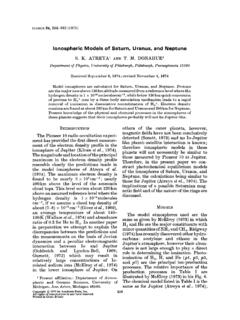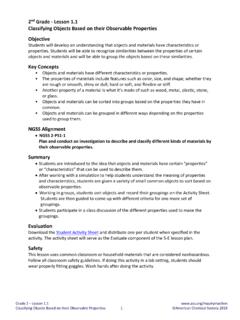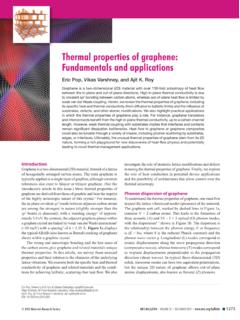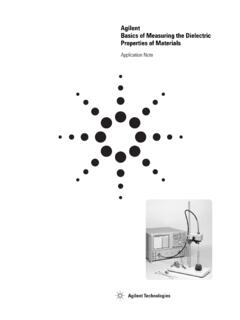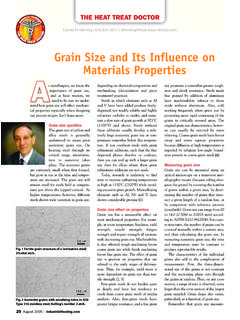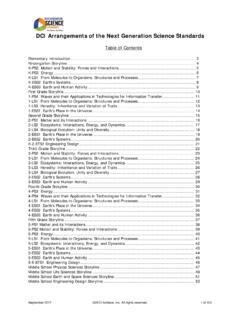Transcription of CERAMICS: Properties 1 (Physical, Chemical, Mechanical)
1 1 CERAMICS: CERAMICS: Properties 1 Properties 1(Physical, Chemical, Mechanical)(Physical, Chemical, Mechanical) BAYNE, BAYNE, Thompson21 University of MichiganSchool of Dentistry,Ann Arbor, MI Southeastern College of Dental Medicine, Ft. Lauderdale, FL will approach all of the major categories of ceramic Properties in this module physical, chemical, and mechanical with key examples for each one. In the following module we will focus on brittle fracture of ceramic PROPERTIESPHYSICAL PROPERTIESMass Properties , thermal, and electrical Mass Properties ( , density)Ceramics are intermediate (density = = gms/cm3)Different for ALLOTROPES ( , glass, cristobalite, tridymite, quartz)2.
2 Thermal Properties :Melting points high (600-4000C)Thermal conductivities are low (insulators)Thermal expansion values are low (1-15 ppm/C)3. Electrical Properties :Electrical conductivity (insulator or semi-conductor)31907 TiC28009 MgO270010 ZrO220508Al2O319756 ZnO18407 TiO2171012 SiO2(Crist.)15609Fe2O3133020 CaF2112020 PbS80040 NaCl646 C54 ppm/CCsClTm = (LCTE) =CeramicMASS Properties include things like density. Ceramics are intermediate in density between polymers (lower) and metals (higher) in the range of 2-6 gms/cm3. Non-crystalline materials are less dense than crystalline ones.
3 Compositions with several ALLOTROPES such as SiO2will have minor differences in density.[CLICK] THERMAL PROPERTIESof ceramics are governed by the type of bonding (covalent to ionic) and number of bonds present . [CLICK]Generally for all materials, the expansion from absolute zero to the melting temperature is about 15%, so materials with higher Tm values have lower LCTE values. This is apparent in the table. [CLICK]You can see that the relationship is semi-logarithmic as shown in the figure. Also, because most ceramics have crystal structures that are not cubic ones, they tend to be ANISOTROPIC.
4 This means they will have different Properties in different directions. [CLICK]Ceramics are electrical insulators under most circumstances. Hydroxyapatite crystals are insulating. Dentin enamel is 89 volume percent hydroxyapatite. Dentin is 50 volume percent hydroxyapatite crystals. Tooth structure therefore is PROPERTIESPHYSICAL PROPERTIESO ptical Optical Properties :Transparency; TranslucencyColor: depends on visible light interaction with ions or pigments (Color from ions [typically ] depends on the oxidation state)Precious (Gems) MineralsRubiesAl2O3with <<<3-4% Cr+3 Blue Sapphires Al2O3with <<<3-4% Co+2 EmeraldsBe-Al-SilicateOpalsHydrated SilicaAmethystsSilica with Mg impurityTopazHydrated F-Al-SilicatePearlsCalcium carbonateand impuritiesMost ceramics are clear ( , transparent).
5 Translucency presumes some transparency with some scattering or diffusion of light. Color depends on interaction of light with ions in the main ceramic or pigments that are added to the ceramic as a secondary phase. [CLICK] Examine the table of characteristic ionic colors for key ions in an oxidized or reduced state. In these cases, the ions function as substitutional defects. [CLICK] To see how this could work, look at precious minerals. Rubies are alumina with small amounts (<<<3%) of Cr+3 included in the composition and generally far less than that. Typical concentrations are and would be considered at the impurities.
6 Most of the precious gems are based on aluminas or silicas, that have been very slightly modified. [CLICK] The other way to produce color is to add in colored phases ( , inorganic pigments). [CLICK] If these same phases are mixed into polymers they are usually called organic pigments or dyes. 4 CHEMICAL PROPERTIESCHEMICAL PROPERTIESC hemical and electrochemical Chemical / Electrochemical corrosion Properties :Very few under normal Solubility:Soluble in certain strong acids (HF) and strong basesUsually non-crystalline (glassy) phases dissolve of selective ion leaching and ion-exchange reactionsCrystallinephaseNon-crystalline matrixPreferential dissolution of non-crystalline phases firstCeramics rarely undergo anything comparable to metal chemical corrosion or electrochemical corrosion.
7 [CLICK] Ceramics generally have good chemical resistance to weak acids and weak bases. However, very strong acids or strong bases tend to produce ion exchange reactions and dissolve the structures. HF is commonly used to intentionally etch ceramic surfaces composed of silicates. It is the F- ion that causes the actual damage. In dentistry, most 2-phase silica-based restorations are treated with 10% HF solutions to etch them. This produces different dissolution that creates micromechanical relief prior to micromechanical bonding. 5 MECHANICAL PROPERTIESMECHANICAL PROPERTIESP roperties depend both on temperature and degree of Mechanical Properties versus melting temperature:Generally strength and modulus go up and down (E) at 25C linearly related to melting temperature (Tm).
8 (Ceramics = 30-350 GPa, Metals = 50-200 GPa, Polymers = <50 GPa)2. Mechanical Properties versus degree of crystallinity:Crystalline phases are low T s, crystalline and non-crystalline phases are high T s approaching Tm, non-crystalline phases are >2800345 SiC2050310Al2O3Tm (C) =E (GPa) =Ceramic:(at room temperature)Ceramics tend to be rigid and brittle ( , not capable of much plastic deformation). However, their Properties depend both on temperature and on the amount of crystallinity. Lower temperatures and higher crystallinity content tend to increase the modulus and the brittleness.
9 Let s look at each effect separately.[CLICK]The figure shows an approximately linear relationship between melting temperature and modulus at room temperature ( , 25C). Remember that if the actual temperature changes, then the stress-strain Properties change. Going up in temperature decreases all values. Going down in temperature increases all values. [CLICK]Next let s look the mechanical Properties versus the actual temperature. Crystalline and non-crystalline phases behave differently at low and high temperatures. At low temperatures, both types of phases are brittle. At high temperatures, crystalline phases are brittle but non-crystalline ones are ductile.
10 To understand this we need to look at why this happens. 6 MECHANICAL PROPERTIESMECHANICAL PROPERTIESG lass transition = TmTEMPERATUREVOLUMETgTmBrittle GlassCrystallineNon-CrystallineDuctile Glass(SupercooledLiquid)LiquidSlope = dV/dT = LCTEC rystallizationSlope = dV/dT = LCTETo understand this behavior you need to understand the GLASS TRANSITION temperature that is associated with the non-crystalline phase. Let s go through the diagram shown.[CLICK]The y-axis is volume. The x-axis is temperature. This is a little bit strange because T is usually the y-axis but this is the way this is usually presented.
